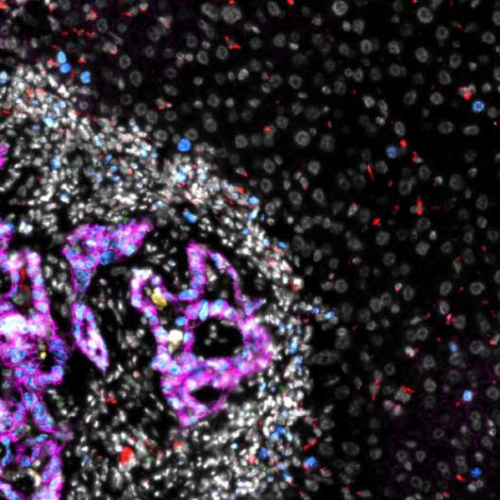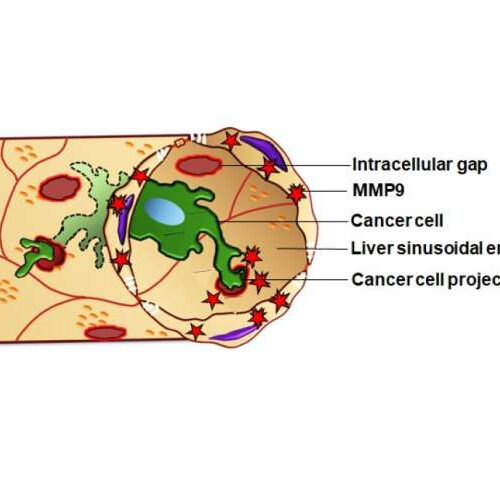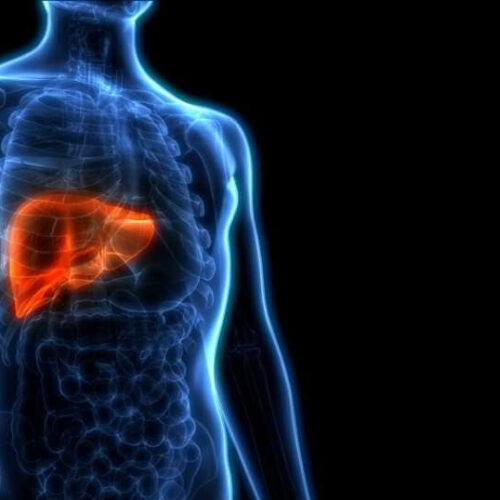Written by Anne Jacobson, MD, MPH | Reviewed by Katie E. Golden, MD Key takeaways: Nonalcoholic fatty liver disease (NAFLD) happens when too much fat builds up in the liver and damages it. Eating certain kinds of food can increase the risk of developing NAFLD.Foods that are high in sugar, fat, and salt put extra...
Tag: <span>Liver</span>
Liver cancer growth tied to tryptophan intake
August 1, 2024 by UT Southwestern Medical Center Summary of our findings on Trp dependency and vulnerability in MYC-driven tumors. Credit: Nature Communications (2024). DOI: 10.1038/s41467-024-47868-3Researchers at UT Southwestern Medical Center have discovered that a diet free of the amino acid tryptophan can effectively halt the growth of liver cancer in mice. Their findings, published...
Researchers uncover how colorectal cancer cells colonize the liver
JULY 24, 2024 by ETH Zurich A colorectal cancer metastasis (left half of the image) in the liver. Colorectal cancer cells, pictured in magenta, surrounded by other cells, in white, within the metastasis (microscopy image). Credit: ETH Zurich / Morgan Roberts, Elena Guido Vinzoni In cases where cancer is fatal, 9 out of 10 times...
New growth factor for the liver identified
by Arne Claussen, Heinrich-Heine University Duesseldorf Microscopic images of so-called human organoids with hepatocytes, which proliferate better with the help of the identified growth factor MYDGF. Credit: HHU/Linda Große-Segerath and Paula FollertA healthy liver is capable of completely regenerating itself. Researchers from Heinrich Heine University Düsseldorf (HHU), University Hospital Düsseldorf (UKD) and the German Diabetes Center...
Experimental weight-loss drug slashed fat in livers of obese people
by Ernie Mundell Retatrutide, an experimental weight-loss drug that could compete against blockbusters Wegovy and Zepbound, may work wonders for obese folks with liver disease, new research shows. A wider study, published in June, found that retatrutide helped obese people lose about a quarter of their starting weight over an 11-month period. Now, findings from...
Switching tracks: Changing the trafficking of the glucagon receptor in the liver regulates its metabolic signaling
by Helmholtz Zentrum München Deutsches Forschungszentrum für Gesundheit und Umwelt (GmbH) Stained liver cells. Credit: Karsten Motzler A group of researchers from the Helmholtz Munich Institute for Diabetes and Cancer (IDC) have unraveled a new strategy to alter glucagon receptor signaling in the liver by changing its intracellular trafficking. Glucagon is a peptide hormone, that...
Study finds the mechanism used by metastatic cancer cells to infiltrate the liver
by ResearchSEA The liver sinusoidal endothelial cells (LSECs, beige) surround a blood vessel containing a cancer cell (green). The cancer cell is able to induce the formation of intracellular gaps (iGaps, red), through inducing MMP9. Credit: Matsubara, Osaka Metropolitan University Metastasis—when cancer spreads to form new tumors—causes approximately 90% of cancer-related deaths. Because metastatic cancer...
Researchers identify the target of immune attacks on liver cells in metabolic disorders
by Weill Cornell Medical College Illustration of human liver anatomy. Credit: Shutterstock When fat accumulates in the liver, the immune system may assault the organ. A new study from Weill Cornell Medicine researchers identifies the molecule that trips these defenses, a discovery that helps to explain the dynamics underlying liver damage that can accompany type 2...
Researchers show how the liver can control the brain and behavior
by Mallory Locklear, Yale University Credit: CC0 Public Domain A new Yale study has found that the liver plays a major role in regulating feeding behavior in mice, a discovery that could have implications for people with eating disorders and metabolic diseases. The study, which was done in collaboration with colleagues in Germany, also adds...
Porous cells lead to poorer livers
by Osaka Metropolitan University High-fat diets weaken gut barrier function, resulting in the migration and accumulation of lipoteichoic acid in the liver. The accumulated lipoteichoic acid stimulates the cleavage of gasdermin D protein, forming cell membrane pores where the SASP factors IL-1β and IL-33 are released from hepatic stellate cells. IL-33 activates regulatory T cells...










